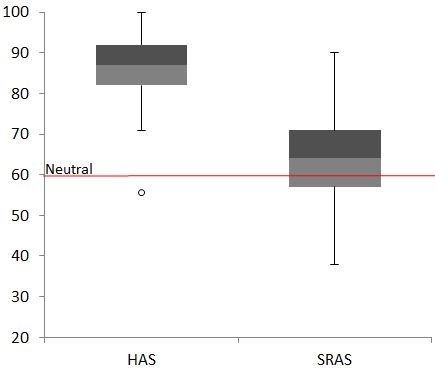Quantifying Altruism in Kidney Donors: How Good Are the Current Scales?
M. McLaughlin, D. Berglund, A. Matas, H. Ibrahim.
U of MN, Mpls.
Meeting: 2015 American Transplant Congress
Abstract number: B190
Keywords: Donation, Kidney, Psychosocial
Session Information
Session Name: Poster Session B: Living Donor Issues 1
Session Type: Poster Session
Date: Sunday, May 3, 2015
Session Time: 5:30pm-6:30pm
 Presentation Time: 5:30pm-6:30pm
Presentation Time: 5:30pm-6:30pm
Location: Exhibit Hall E
The decision to become a living kidney donor is complicated and altruism is certainly what drives the majority of organ donors. Unfortunately, there are no objective methods for assessing altruism nor the extent altruism tools have been tested in live donors.
A representative random sample of living kidney donors (n=253) were asked to complete the Helping Attitude Scale (HAS) and Self-Report Altruism Scale (SRAS) surveys. Both surveys were validated in "normal" college students; Cronback's α 0.86 and 0.84, respectively. The HAS survey was published in 1998 and the SRAS in 1981. Scores range from 20 to 100; increasing scores are associated with increasing altruism, neutral = 60. In addition, we asked participants if they felt that these two tools are truly applicable to kidney donors.
Of the 253, n=125 (49%) responded. Responders were 99% white, 62% female, 78% related to the recipient, and 2% non-directed. 47% were a sibling of the recipient, 14% child, 14% parent, and 8% spouse, the remaining were either a more distant relative or not related. The mean time from donation to survey completion was 21.3±9.4 years at a mean age of 62.9±9.1 yrs.
The HAS survey measures general beliefs related to helping others (ex. volunteering to help someone is very rewarding); answers range from "strongly disagree" to "strongly agree". The mean score in donors was 86.9±7.6, median 87 (Figure 1). This was significantly higher than the reported general population (79.6±8.7), p<0.001. 1 donor (0.01%) scored ≤60 (not altruistic). 91 (73%) felt the HAS survey would determine if a potential donor was altruistic.
The SRAS survey evaluates the frequency of which responders have engaged in specific altruistic behaviors (ex. I have donated goods to charity) from "never" to "very often". Donors scored 63.7±9.5, median 64. Donors again scored higher than the general population (55.6±11.0), p<0.001. 51 (41%) scored ≤60. 88 (70%) felt the SRAS survey would determine if a potential donor was altruistic.
These data indicate that donors score surprisingly only slightly higher than the general population and only half have engaged in prior altruistic activities.
Figure 1. Altruism Scores in Living Donors
To cite this abstract in AMA style:
McLaughlin M, Berglund D, Matas A, Ibrahim H. Quantifying Altruism in Kidney Donors: How Good Are the Current Scales? [abstract]. Am J Transplant. 2015; 15 (suppl 3). https://atcmeetingabstracts.com/abstract/quantifying-altruism-in-kidney-donors-how-good-are-the-current-scales/. Accessed July 1, 2025.« Back to 2015 American Transplant Congress
